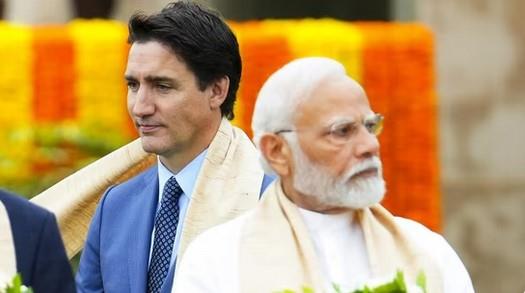
Testing Time For India's Foreign Policy
Colombo, October 31: India has reached a stage where it sees itself as a power that can pursue its“national interest” in defiance of the top dogs of the world order. Undeniably, India has successes in the economic and technological fields to validate its claim to an extent.
India is wooed by the major powers of the world including the US and Russia. Even rival China wants to cooperate with India in the economic field keeping the border dispute on the backburner. There is a clamour among a growing section of intellectuals in Pakistan that Islamabad should recognise India's rise and develop economic ties with it, putting the Kashmir dispute in the side track.
ADVERTISEMENTRecently, Pakistan made overtly friendly gestures towards India, even if only to make the fussy Indians attend the Shanghai Cooperation Organization (SCO) summit it was hosting.
India's relations with China continue to be troubled, but again, recent developments show that there is light at the end of the tunnel, however faint it may be.
Unpleasant Ground Realities
That said, there are unpleasant realities that cannot be ignored. In recent weeks, India's ties with the US, Canada and Bangladesh have deteriorated in varying degrees – very sharply in the case of Canada and Bangladesh, and to a lesser extent in the case of the US. Relations with Canada have actually haemorrhaged.
Ironically, the problems with the Canada, US, and Bangladesh are, at least partly, the result of India's own bid to emulate the existing super powers imagining itself as being in the same league and imposing its will on other countries. India had over-extended its arm due to over confidence, and paid for it.
Canada
The downturn in relations with Canada stemmed from the latter's harbouring Sikh extremists, terrorists and separatists despite appeals from India to either tame them or extradite them to face trial in India. But Canada would insist that no action could be taken against citizens unless they broke Canadian laws. Canada also insisted that agitating for any cause however obnoxious would be allowed if it is peaceful.
In this context, the murder of Sikh terrorist Hardeep Singh Nijjar, a Canadian citizen on Canadian soil in June 2023, proved to be the last straw for Canada. Canadian Prime Minister Justin Trudeau and the police charged that Indian intelligence agencies had Nijjar killed by using a hired assassin. They further charged that a former Indian policeman Vikash Yadav, in collusion with the Indian High Commissioner in Canada and other Indian mission officials, were complicit. The envoy Kumar Verma and six other officials were asked to leave Canada though India said that they had been recalled for security reasons.
India described the Canadian charge as“preposterous” and levelled the counter charge that Canada had been cultivating anti-Indian Sikh separatists to win the votes of 770,000 Sikhs in Canada.
United States
To India's discomfiture, the US too joined Canada in charging that its intelligence agency was plotting to kill dissidents abroad. The US said that an American Sikh separatist, Gurpatwant Singh Pannun, had been a target of Indian assassins. The Pannun case had gone to court and an Indian agent allegedly involved in the plot was extradited from the Czech Republic and brought to the US for trial.
The US prosecutor went to the extent of naming the National Security Advisor of India Ajit Doval as a“person of interest” and issued a summons. This prevented Doval from accompanying Prime Minister Narendra Modi on his visit to the US to attend the UN General Assembly session in September.
But India stoutly denied involvement and hinted that Nijjar's killing could have been the result of Sikh gang warfare in Canada. In the case of Pannun, India said that it could be a plot by the Indian gangster Lawrence Bishnoi, currently in a Gujarat jail in a string of murder and extortion cases.
However, in contrast to the outburst over Canada's allegations, the Indian response in Pannun's case was muted. India even despatched a team to the US to discuss the matter, deepening the mystery of the plot.
There have been hints of a deal being worked out to keep Indo-US relations from plummeting further. It would be interesting to see if the US would intervene in the Pannun case in a New York court to get India off the hook. This is because both the US and India stand to lose if their dirty linen is washed in public.
Both India and the US have too much at stake in the relations to allow ties to be hampered. The two have close defence and strategic ties to counter China. The arms trade between India and the US has touched USD 25 billion. Modi had recently cleared a USD 3 billion drone deal. India-US defence and intelligence cooperation is also considerable with the signing of key agreements.
In 2023, US investments in India were valued at approximately USD 49.6 billion and Indian investment in the US amounted to USD 4.6 billion. In comparison, the total bilateral Indo-Canadian trade is peanuts –only USD 8 billion. This is the reason why, India has been soft on the US charges and hard on Canada's.
Though India and the US both have real constraints in fighting each other, they will keep encountering points of friction as they have divergent domestic and foreign policy interests even as they are“strategic partners” in checking China's expansionism.
India is worried about the leeway being given to Indian terrorists and separatists in Canada and the US. New Delhi is duty bound to safeguard India's sovereignty and territorial integrity. Moreover, Indian public opinion sees nothing wrong in India's assassinating terrorists at home or abroad if India can pull it off. It is therefore necessary for Western countries to take India's concerns and compulsions seriously and with respect.
The US has interests in India which it cannot set aside. It is helping India militarily in the hope that India will, if needed, go to war with China and check its advancement in South Asia. But India baulks at the prospect of a war with China which has an economy five to seven times the size of the Indian economy. China is also armed to the teeth.
With many Indian industries depending on imports of intermediate goods from China, Indian cannot break ties with China. India buys USD 100 billion worth of goods from China annually to keep its industries humming. India is basically interested in a détente on the India-China border and to achieve it, it wants to buy American military equipment. That's about it.
Sino-Indian Border Deal
Partly due to its friction with the US, India is trying to come to some agreement with China on the disputed parts of the 4,000 km India-China border. And on its part, China wants to wean India away from the US camp.
Indian Prime Minister Narendra Modi and Chinese President Xi Jinping met on the side lines of the 16th BRICS Summit at Kazan in Russia on October 23. They agreed to have a“complete military disengagement” on the disputed parts of the border. The pact involves allowing militaries from both sides to patrol contested sections. It aims at preventing border clashes and ensuring that the countries can“quickly de-escalate” when there are disputes, according to Indian officials. China said that Beijing would work in the next stage to“properly implement the plan with the Indian side.”
The 2020 border clash in Galwan had killed 20 Indian and four Chinese soldiers. Smaller clashes took place in 2021 and 2022, raising fears of bigger clashes between troops in close proximity along disputed stretches.
“The deal in Kazan marks a major step in trying to normalize ties between the two countries,” said Manoj Joshi at the Observer Research Foundation in New Delhi.“Both countries are trying to lower the temperatures, but of course there is still a long distance to go.”
But critic General (Rtd) Prakash Katoch says that still Indian troops can't patrol 26 out of 65 patrolling points claimed by India.
Critics also point out that while China does not open its market much to Indian goods, India has relaxed visa rules for Chinese technicians. Chinese investment has been allowed in the electronics sector. Chinese companies can now take smaller stakes in joint ventures.
According to neutral commentators, both India and China have limited incentives and no compulsion to engage in substantial bilateral dialogue. The same holds true for India-Pakistan relations. There is peace on the India-Pakistan Line of Actual Control (LAC) in Kashmir due to a military-to-military agreement.
But the political rhetoric over Kashmir in Pakistan and over Pakistani cross-border terrorism in India, continues unabated. This is because the issues that divide the two countries play a key part in electoral politics.
Bangladesh
India-Bangladesh relations, cited as a great success for over a decade, touched rock bottom in August following the violent overthrow of the Sheikh Hasina regime by a popular movement against corruption and dictatorial rule.
Trouble for India stemmed from the fact that the forces behind the movement saw Hasina as lackey of India. It was thought that she was able to rule with an iron hand and rig election after election with India's help. The fact that the fleeing Hasina was given shelter in New Delhi seemed to confirm the theory.
India was surprised by the extent of revulsion against Hasina and itself. The government of New Delhi went into a shell. But the Indian media went hammer and tongs against the successor government in Dhaka. The popular movement was seen as the handiwork of Pakistan, China and the US.
Unless the Indian media tones down its vicious anti-Bangladesh rhetoric, chances of an Indo-Bangla rapprochement are dim indeed.
END

Legal Disclaimer:
MENAFN provides the information “as is” without warranty of any kind. We do not accept any responsibility or liability for the accuracy, content, images, videos, licenses, completeness, legality, or reliability of the information contained in this article. If you have any complaints or copyright issues related to this article, kindly contact the provider above.






















Comments
No comment